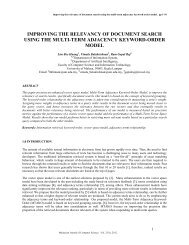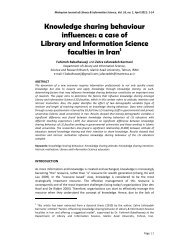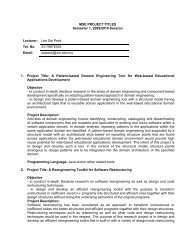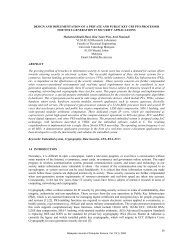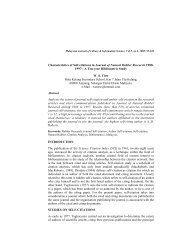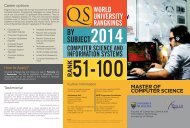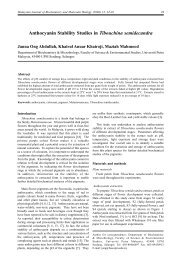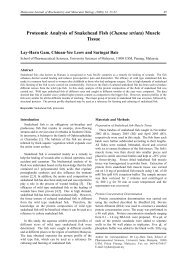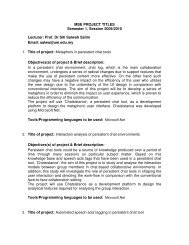Co-authorship network of scientometrics research collaboration - E-LIS
Co-authorship network of scientometrics research collaboration - E-LIS
Co-authorship network of scientometrics research collaboration - E-LIS
- No tags were found...
Create successful ePaper yourself
Turn your PDF publications into a flip-book with our unique Google optimized e-Paper software.
Erfanmanesh, M.; Rohani, V.A. & Abrizah, A.CONCLUSIONThis study has examined the <strong>scientometrics</strong> co-<strong>authorship</strong> <strong>network</strong>s <strong>of</strong> authors, institutions,countries and by academic fields using the data from the journal Scientometrics. This is a limitation<strong>of</strong> the study as it does not take into account papers on <strong>scientometrics</strong> published elsewhere such asJournal <strong>of</strong> Informetrics, Journal <strong>of</strong> the American Society for Information Science and Technology(JASIST) and Research Evaluation. The key findings <strong>of</strong> this study on the community <strong>of</strong>scientometricians are as follows:a) The percentage <strong>of</strong> co-authored papers represents 54.78% <strong>of</strong> the total number <strong>of</strong> paperspublished in the journal Scientometrics;b) The scientometrician’s <strong>collaboration</strong> <strong>network</strong> forms “small-world” topology in which twoauthors randomly selected are typically separated by a short path, and has demonstratedthe presence <strong>of</strong> clustering;c) The distribution <strong>of</strong> vertices degree centrality in the <strong>collaboration</strong> <strong>network</strong> <strong>of</strong>scientometricians follows the power-law distribution. In this <strong>network</strong>, we have a greatnumber <strong>of</strong> authors with small degrees and a small tail <strong>of</strong> authors with large degrees;d) The co-<strong>authorship</strong> <strong>network</strong> <strong>of</strong> authors in the field <strong>of</strong> <strong>scientometrics</strong> consists <strong>of</strong> 1570components, the largest <strong>of</strong> which contains 459 vertices, yielded a ratio <strong>of</strong> 15.17% <strong>of</strong> thewhole <strong>network</strong>;e) Thirteen scientometricians, Glanzel, Rousseau, Debackere, Schubert, Moed, Gupta, Braun,Thijs, Liang, Leydesdorf, Meyer, Kretschmer and Leta are strategically positioned in the<strong>network</strong> due to both their productivity and centrality.f) University <strong>of</strong> Leuven, Hungarian Academy <strong>of</strong> Science, University <strong>of</strong> Antwerp, KHBO,University <strong>of</strong> Granada, University <strong>of</strong> Amsterdam, Spanish National Research <strong>Co</strong>uncil, LeidenUniversity and National Institute <strong>of</strong> Science, Technology and Development Studies occupythe topmost positions in various rankings, which indicate their absolute status in<strong>scientometrics</strong> <strong>research</strong>.g) The United States, although has no representative in the top 20 most influential and centralinstitutions, occupies the topmost positions in all measures except for degree centrality.Belgium, Netherlands, Span, England, Germany, Hungary and China come after US based onproductivity, centrality and <strong>collaboration</strong>.h) The most active, central and collaborative academic fields in <strong>scientometrics</strong> <strong>research</strong> areSocial Sciences, Economics and Business, Clinical Medicine, Physics, Chemistry andPsychiatry and Psychology; with Information and Library Sciences as the most productivediscipline in social sciences producing <strong>scientometrics</strong> <strong>research</strong>.Although the study has included a time span <strong>of</strong> more than three decades (1980-2012) for the<strong>scientometrics</strong> co-<strong>authorship</strong> <strong>network</strong>, the temporal dimension, i.e. to see whether the practices <strong>of</strong>co-<strong>authorship</strong> <strong>of</strong> various institutions and countries relationships have changed over time, has notbeen explored in this study. However, the positive evolutions <strong>of</strong> the main component <strong>of</strong> the<strong>scientometrics</strong> <strong>collaboration</strong> <strong>network</strong> coupled with the presence <strong>of</strong> a number <strong>of</strong> key individuals areevidence <strong>of</strong> the healthy status <strong>of</strong> the <strong>scientometrics</strong> <strong>research</strong> community. Unlike a similar analysis <strong>of</strong>the information systems community (Xu and Chau 2006), the <strong>scientometrics</strong> scene was notdominated by a couple <strong>of</strong> key <strong>research</strong>ers as quite a significant number <strong>of</strong> popular <strong>research</strong>ers wereidentified. This is the pro<strong>of</strong> <strong>of</strong> community’s ability to attract new members over the years and toproduce new generations <strong>of</strong> popular <strong>research</strong>ers. The <strong>scientometrics</strong> <strong>research</strong> community wasfound to be a healthy small-world community that kept evolving in order to provide an environmentthat supports <strong>collaboration</strong> and sharing <strong>of</strong> ideas between <strong>research</strong>ers in quantitative study <strong>of</strong><strong>research</strong> communication.Page | 90



